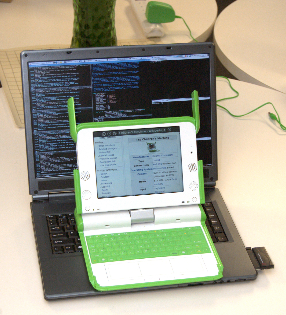Emulating the XO
| modify |
Emulators allow you to run a "virtual machine" on a (reasonably powerful) host machine. There are a number of emulator systems available which can be used to run a simulated OLPC-XO.
See the Developer's Manual for a discussion of the general merits of the various packages and the ways you might want to use emulation in the development process.
See Comparison of alternatives below for a grid showing which environments have been tested and found to work on what host operating systems.
- Quick Start
- Get started ASAP using QEMU and an official image
- Platform Specific Notes
- Configuration and Usage
- Configuration and Usage of Qemu
- VMWare, VirtualBox -- include the system-specific operations required
- Help and tips
- limitations with XO disk images
- Category:Emulation
- Tutorial Written by IBM on how to get this working.
- Improving emulation
The emulators currently don't deal very gracefully with the XO's unusual 1200x900 screen size. So what you see is not quite what you would on a real XO, unless you are running a remote X server (as described elsewhere). Running emulation in 1280x1024 is pretty close, but most emulation defaults to 1024x780 to better fit on more people's monitors.
Emulating the XO is important not only to test software for the system, but also for people to be able to provide day-0 support on all the technical issues that will arise on the XO in countries having access to the device and system for the first time. To fulfill these needs, it will be important to make emulating the XO laptop easy, accessible, and available to many people all over the world.
Comparison of alternatives
An OLPC laptop is custom hardware, running a stripped-down Red Hat linux, running Sugar. But what if you don't have a real olpc laptop? There are a several options, which can each be used in a couple of ways.
| platform | purpose | recommendation |
|---|---|---|
| Ubuntu | play & development | xo disk images on qemu. See Emulating the XO/Quick Start. |
| Ubuntu 32-bit | core development | Sugar with sugar-jhbuild and Sugar on Ubuntu Linux |
| Fedora | play & development | xo disk images on qemu. See Emulating the XO/Quick Start. Perhaps also on VirtualBox? |
| Fedora 32-bit | core development | Sugar with sugar-jhbuild and Category:Installing_Sugar |
| Gentoo 32-bit | core development | Sugar with sugar-jhbuild in F7 on qemu. Or Sugar on Gentoo Linux (more invasive, less stable). |
| Other linux & FreeBSD | play & development | xo disk images on qemu. See Emulating the XO/Quick Start. Perhaps also on VirtualBox? |
| Windows | play & development | emulated xo disk image, on VirtualBox, VMWare, or QEMU on Windows. |
| Mac | play & development | emulated xo disk image, on qemu or VMWare. See Emulating the XO/Quick Start/Mac. Perhaps also VirtualBox? See also /Mac. |
| Mac with VMWare fusion | core development | Fedora 7 in VMWare and Sugar with sugar-jhbuild, sound and networking work. See /Mac |
| Mac with Parallels | play | emulated xo disk image, networking works after manually "dhclient eth0", sound does not work (Build 593). |
| Mac with Parallels | core development | run Ubuntu 32-bit, and Sugar on Ubuntu Linux. See /Mac. F7 may be better - see below |
Discussion:
- Is F7 better than Ubuntu for sugar-jhbuild? If so, should the Mac Parallels recommendation for core development be F7 rather than Ubuntu, despite the latter having a track record in /Mac? MitchellNCharity 10:33, 20 September 2007 (EDT)
- Yes, you will have less problems with Fedora 7, once you get it working in Parallels (which is harder than Ubuntu I think). I am running F7 because I need to be able to build RPMs. Bert 08:33, 25 September 2007 (EDT)
- QEMU or VirtualBox or VMWare?
Build recommendations
For running XO disk images on an emulator, some builds are better than others, and the most recent one will not always work. Here is a summary of current status. Please add your own experiences here, and in User Feedback on Images.
Current joyride builds generally work (as of ~1400). Presence service (mesh view and collaboration) wont work by default, because they are configured with a presence service providing jabber server of ship2.jabber.laptop.org, which doesn't yet exist. There is an overloaded and fragile jabber.laptop.org which may be used in the meantime. MitchellNCharity 22:42, 14 December 2007 (EST)
